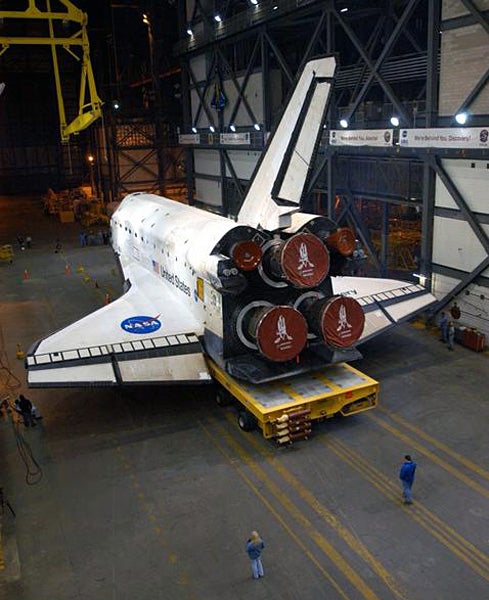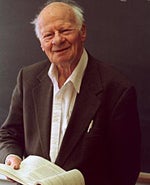Discovery rolls
On Monday morning, NASA’s space shuttle Discovery rolled closer to launch, moving from its Kennedy Space Center hangar to the Vehicle Assembly Building (VAB). There, Discovery will be attached to its propulsion stack: the redesigned external fuel tank and twin solid rocket boosters.
“Seeing the orbiter roll to the VAB is the culmination of all that hard work. We look forward to a safe return to flight,” said Stephanie Stilson, Discovery’s vehicle manager.
Discovery’s mission is designated STS-114 and has a launch window from May 15 to June 3. The mission, commanded by astronaut Eileen Collins, will carry a six-person crew and deliver supplies to the International Space Station. It’s the first of two test flights to check out new shuttle inspection and repair techniques devised in the aftermath of the Columbia accident February 1, 2003.
NASA expects Discovery will begin its 4-mile journey to Launch Pad 39-B sometime next week. — Francis Reddy
Deep Impact lacks focus
While commissioning the Deep Impact spacecraft now on course for a July 4 flyby of Comet Tempel 1, NASA engineers hit a snag with the probe’s highest-resolution telescope. They aren’t able to bring it to sharp focus.
One aspect of the commissioning phase includes heating the spacecraft’s High Resolution Instrument (HRI) to remove any moisture absorbed into the telescope’s barrel during the craft’s last hours on the launch pad.
“We are very early in the process of examining the data from all the instruments,” says Michael A’Hearn of the University of Maryland in College Park. Even if the HRI’s focus doesn’t improve, he says, “[W]e still expect to obtain the best, most detailed pictures of a comet ever taken.”
On July 3, Deep Impact will release an impactor into the comet’s path for a planned collision at about 23,000 mph (37,000 km/h). Scientists expect the resulting crater will range from the width of a house to the size of a football stadium, giving scientists their first glimpse at a comet’s interior. — Francis Reddy
AAS disappointed about HST decision
The American Astronomical Society (AAS), the world’s largest professional organization for astronomers and astrophysicists, today released a statement Expressing their disappointment that NASA will not servive the Hubble Space Telescope (HST).
The diplomatic statement outlines Hubble’s contributions, while slightly criticizing NASA. They argue the future scientific rewards outweigh further costs and fiscal consequences involved. The society closes by confirming its commitment to working with NASA. The statement lacks the harsh criticism generated by much of the science community over the servicing decision. AAS President Robert Kirshner did provide his own view.
Upon issuing the statement, Kirshner added, “I am personally very disappointed with NASA’s current plan not to service HST. You can be sure we will work with them to help realize the goals of astronomers as carefully worked out through our decade plan. We know that NASA is committed to doing the world’s best astronomy and servicing Hubble with the Shuttle is part of the best program.” — Jeremy McGovern
| The AAS statement |
| The Hubble Space Telescope has been the crown jewel in NASA’s science programs for over a decade. Its accomplishments have revolutionized our understanding of the universe in which we live, and it has inspired a new generation of students and the public at large with its discoveries. This remarkable performance can be expected to continue if HST is serviced. NASA’s recently announced decision to forego any option to service the HST is therefore viewed with considerable disappointment by the American Astronomical Society and the astronomical community. While we recognize that HST’s mission must end at some time, the fact that a servicing mission was a part of NASA’s planned activity, and that two key replacement science instruments are already developed to enable important and exciting new science, makes this decision particularly unfortunate and difficult to accept.
Much of the success of NASA’s space science program is due to strong community involvement in planning and setting priorities based upon scientific merit and relevance to a coherent science program. Therefore, the AAS strongly concurs with the view advocated by the recently released report of the NRC Committee to Assess Progress Toward the Decadal Vision in Astronomy and Astrophysics. Specifically, that NASA should continue with the missions and programs as prioritized in the NRC report “Astronomy and Astrophysics in the New Millennium.” In particular, should a HST servicing mission have adverse budget consequences, the AAS urges NASA to include the space science communities in an assessment of the relative scientific merits of all impacted missions, in line with the decadal survey process. Finally, the AAS notes that HST is a component of a dynamic, exciting, and evolving set of astronomy and space science missions. We applaud NASA’s continuing commitment to maintaining a “world-class astronomy program,” as expressed in Acting Administrator Gregory’s testimony on February 17, 2005 to the House Science Committee. This commitment is an essential element of the Vision for Space Exploration, and the AAS stands ready to work with NASA to assure that strong programs in space science continue as NASA implements the Vision. |
Hans Bethe (1906–2005)
Cornell University’s Hans Bethe died March 6 at the age of 98 in Ithaca, New York. A Nobel laureate, Bethe (pronounced BAY-tah) was a giant in modern physics alongside Neils Bohr, Enrico Fermi, Werner Heisenberg, and Robert Oppenheimer.
“The world has lost one of the great pioneers of 20th century physics, and Cornell has lost a beloved teacher, mentor, and friend,” says Cornell President Jeffrey S. Lehman. “In the breadth of his insight, the rigor of his research, the depth of his social conscience, and the steadfastness of his commitment to Cornell, Hans Bethe set the standard for engaged scientific citizenship that will serve as a beacon for generations to come.”
Born in Strasbourg, Alsace-Lorraine, Bethe left Germany in 1933 after losing a teaching position because of his Jewish heritage. He immigrated to England, but eventually settled in the United States at Cornell University. Bethe remained with the university until his death.
In 1939, Physical Review published “Energy Production in Stars,” Bethe’s influential paper on the theory of stellar energy production that explains how the Sun shines. Through this work, he eventually won the 1967 Nobel Prize in Physics.
During World War II, Bethe served as head of the Manhattan Project’s theoretical physics division at Los Alamos, New Mexico, and helped develop the first atomic bomb. Following the war, he promoted peaceful usage of nuclear energy and championed nuclear arms control. In 1963, He persuaded the United States. to ban atmospheric nuclear tests and antiballistic missile systems in 1972.
Bethe is survived by his wife, two children, and three grandchildren. — Jeremy McGovern
Spitzer discovers invisible galaxies
Astronomers using the infrared-sensitive Spitzer Space Telescope have discovered 31 galaxies that are big and extremely bright — but so cloaked in dust that they are invisible, except at mid-infrared wavelengths. The galaxies lie 11 billion light-years away and date from 3 billion years after the Big Bang. Each has a brightness of roughly 10 trillion Suns, or a thousand times that of the Milky Way.
In The Astrophysical Journal Letters (published on-line March 3), a team of astronomers led by James Houck of Cornell University reports finding absorption bands from silicate dust in the spectra of 17 of the 31 galaxies. The spectral bands let the researchers tell how far away the galaxies were by their redshifts, a measure of the universe’s expansion as well as both the object’s distance and age.
“This is very exciting for Spitzer,” says Chuck Steidel, a galaxy researcher at Caltech who is not part of Houck’s team. “Discovering galaxies and getting redshift spectra of them with the same instrument were what Spitzer was designed to do.” Previously, he says, similar research had to follow up the discovery using spectra taken by telescopes on the ground.
In 1983, the InfraRed Astronomy Satellite (IRAS) faintly detected similarly dust-wrapped galaxies, but much closer to Earth. Later, comparable galaxies nearby were found by the Infrared Space Observatory. — Robert Burnham












